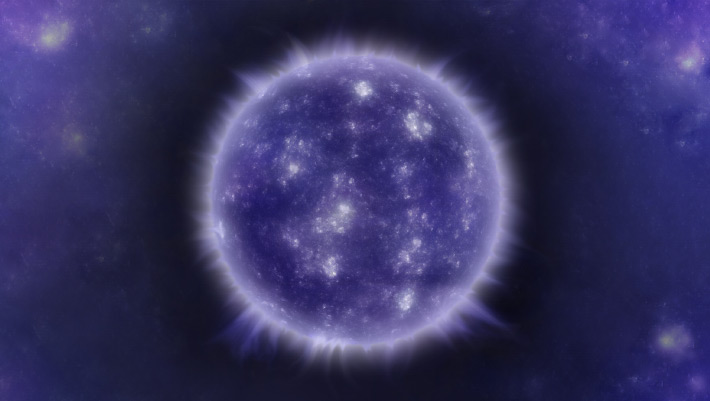The first generation of stars in the universe is yet to be observed. There are two leading theories about these objects: hydrogen-burning Population III stars and the so-calleddark stars,” made of hydrogen and helium, but powered by dark matter heating rather than nuclear fusion. New research shows that JADES-GS-z13-0, JADES-GS-z12-0 and JADES-GS-z11-0, three high-redshift candidate galaxies discovered by the NASA/ESA/CSA James Webb Space Telescope – are consistent with a supermassive dark star interpretation, thus identifying the first dark star candidates.
 An artist’s impression of a supermassive dark star. Image credit: Sci.News.
An artist’s impression of a supermassive dark star. Image credit: Sci.News.
Dark matter is the mysterious substance that makes up about 25% of the universe.
There is strong indirect evidence for its existence from measurements of cosmic primary radiation, anomalies in the radial dependence of galactic rotation curves, and gravitational lensing.
Despite its apparently pivotal role in the universe, the physical origin of dark matter remains unknown.
Theoretical physicists suspect that it is made of invisible particles that neither reflect nor absorb light, but can exert gravity.
Experiments around the world are trying to detect and study such particles. Among the leading candidates are WIMPs (weakly interacting massive particles).
When they collide, these particles self-destruct, depositing heat into shrinking clouds of hydrogen and turning them into brightly shining dark stars.
The identification of supermassive dark stars would open up the possibility of studying dark matter based on their observed properties.
Follow-up Webb observations of the objects’ spectroscopic properties may help confirm whether these candidate objects are indeed dark stars.
Confirming the existence of dark stars could also help solve a problem created by Webb: There appear to be too many large galaxies in the early universe to fit the predictions of the Standard Model of cosmology.
“It’s more likely that something within the Standard Model needs tweaking, because coming up with something entirely new like we did is always less likely,” said Dr. Kathryn Freese, an astrophysicist at the University of Texas at Austin.
“But if some of these objects that look like early galaxies are actually dark stars, the simulations of galaxy formation agree better with the observations.”
 JADES-GS-z13-0, JADES-GS-z12-0 and JADES-GS-z11-0 were discovered by the JWST JADES program. Image credit: Robertson and others., arXiv: 2212.04480.
JADES-GS-z13-0, JADES-GS-z12-0 and JADES-GS-z11-0 were discovered by the JWST JADES program. Image credit: Robertson and others., arXiv: 2212.04480.
JADES-GS-z13-0, JADES-GS-z12-0 and JADES-GS-z11-0 were initially identified as galaxies in December 2022 by the JWST Advanced Deep Extragalactic Survey (JADES).
Using spectroscopic analysis, the JADES team confirmed that the objects were observed 320 to 400 million years after the Big Bang, making them some of the earliest objects ever seen.
“When we look at the Webb data, there are two competing possibilities for these objects,” Dr Freese said.
“One is that they are galaxies containing millions of ordinary Population III stars. The other is that they are dark stars.
“And believe it or not, a dark star has enough light to compete with an entire galaxy of stars.”
Dark stars could theoretically grow to several million solar masses and up to 10 billion times brighter than the Sun.
“We provided for back in 2012 that supermassive dark stars could be observed with Webb,” said Dr. Cosmin Ilie, an astrophysicist at Colgate University.
“Finding a new type of star is quite interesting in itself, but finding the dark matter that powers this – that would be huge,” Dr Friese said.
This study is described in a paper in Proceedings of the National Academy of Sciences.
_____

